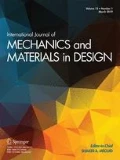Abstract
Automobiles and trucks have shock absorbers to damp out the vibration experienced due to roughness of the roads. However, energy in conventional shock absorbers gets dissipated as heat and is not used in any way. Regenerative electromagnetic shock absorbers provide a means for recovering the energy dissipated in shock absorbers. Two configurations of regenerative electromagnetic shock absorber have been developed for this purpose: a linear device and a rotary device. Performance of these shocks in a laboratory test stand and in a small all terrain vehicle is described.










Similar content being viewed by others
Abbreviations
- B i :
-
Magnetic flux in T
- f :
-
Frequency in Hz
- F :
-
Force in N
- H :
-
Height of pole ring in mm
- I :
-
Current in A
- K :
-
Constant (nhBi) in volt-s/m
- L :
-
Length in mm
- n :
-
Number of turns/mm
- P :
-
Power generated in W
- Rc:
-
Total resistance of coils in Ω
- R L :
-
Resistance of external load in Ω
- v :
-
Velocity in m/s
- V :
-
Voltage in V
References
Browne, A.L., Hamburg, J.A.: On-road measurement of the energy dissipated in automotive shock absorbers, Symposium on Simulation and Control of Ground. Vehicles Transport. Syst. 2, 167–186 (1986)
Fodor, M.G., Redfield, R.: The variable linear transmissions for regenerative damping in vehicle suspension control. Vehicle Syst. Dyn. 22, 1–20 (1993)
Goldner, R.B., Zerigian, P., Hull, J.R.: A preliminary study of energy recovery in vehicles by using regenerative magnetic shock absorbers, Paper SAE 2001-01-2071, SAE/DOE Government/Industry Meeting, Washington, DC, May 14–16 (2001)
Graves, K.E., Iovenitti, P.G., Toncich, D.: Electromagnetic regenerative damping in vehicle suspension systems. Int. J. Vehicle Designs 24(2/3), 182–197(2000)
Gupta, A., Mulcahy, T.M., Hull, J.R.: Electromagnetic shock absorbers, XXI International Modal Analysis Conference Proceedings, Paper#181 (CD Rom), Kissimmee, FL, Feb 3–6 (2003)
Karnopp, D.: Permanent magnet linear motors used as variable mechanical dampers for vehicle suspensions. Vehicle Syst. Dyn. 18, 187–200 (1989)
Rani, S.: Bose breakthrough: electromagnetic auto suspension. Siliconeer, January (2005)
Strait, D.A., Kulakowski, B.T., Sebaaly, P.E., Wollyung, R.J.: Road simulator study of heavy-vehicle wheel forces. Federal Highway Administration Publication, FHWA-RD 98, 019, September (1998)
Suda, Y., Shiba, T.: New hybrid suspension system with active control and energy regeneration. Vehicle Syst. Dyn. Suppl. 25, 641–654 (1996)
Acknowledgements
Work at Argonne National Laboratory was supported by the U.S. Department of Energy, Office of Heavy Vehicle Technologies and Office of Advanced Automotive Technologies, under Contract W-31-109-Eng-38.
Author information
Authors and Affiliations
Corresponding author
Additional information
The submitted manuscript has been created by the University of Chicago as Operator of Argonne National Laboratory (“Argonne”) under Contract No. W-31-109-ENG-38 with the U.S. Department of Energy. The U.S. Government retains for itself, and others acting on its behalf, a paid-up, nonexclusive, irrevocable worldwide license in said article to reproduce, prepare derivative works, distribute copies to the public, and perform publicly and display publicly, by or on behalf of the Government.
Rights and permissions
About this article
Cite this article
Gupta, A., Jendrzejczyk, J.A., Mulcahy, T.M. et al. Design of electromagnetic shock absorbers. Int J Mech Mater Des 3, 285–291 (2006). https://doi.org/10.1007/s10999-007-9031-5
Received:
Accepted:
Published:
Issue Date:
DOI: https://doi.org/10.1007/s10999-007-9031-5




